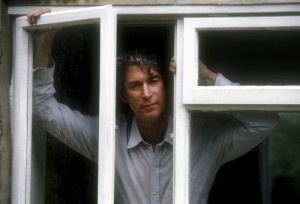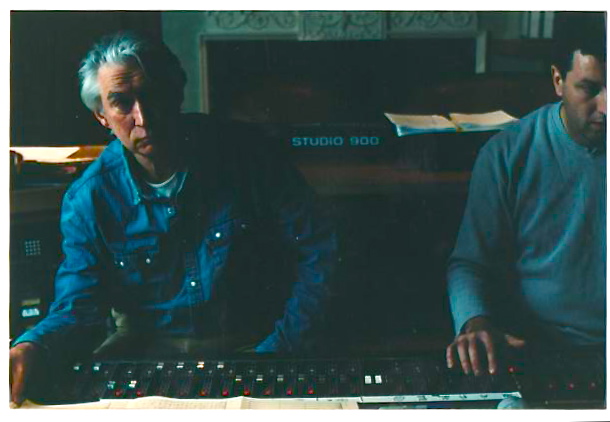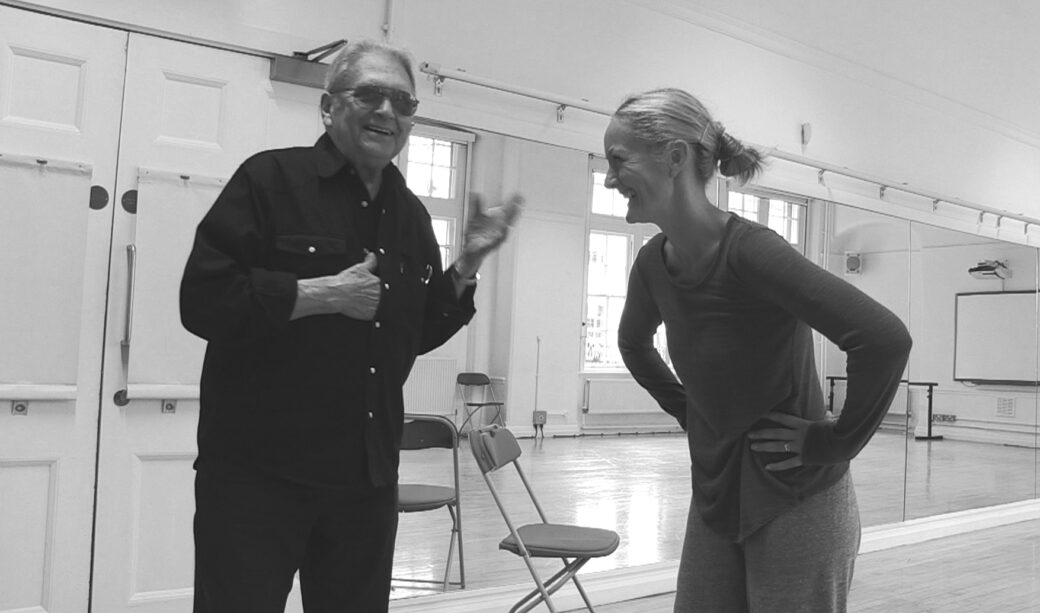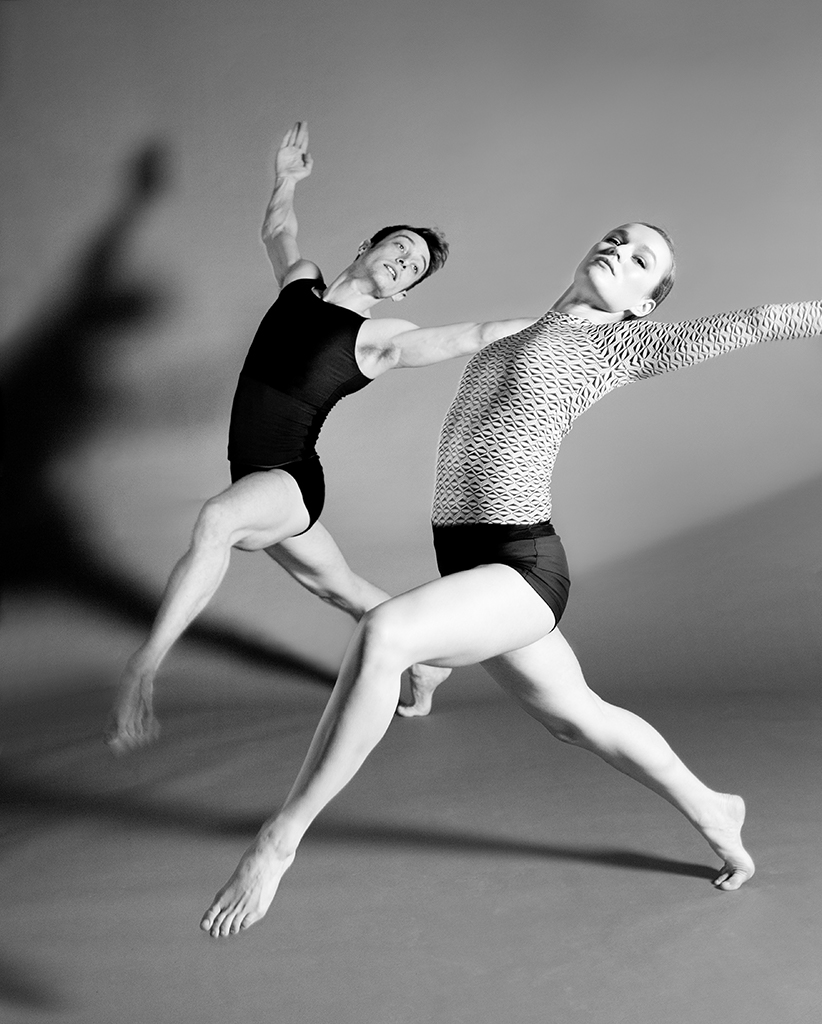I attended Bob Cohan’s 90th Celebration at The Place last Friday, March 27th. The man who has been described as ‘the forefather of British contemporary dance’ was a member of Martha Graham’s company for more than ten years, and taught at the Martha Graham School in New York. When, in 1967, he became the Artistic Director of London Contemporary Dance Theatre (based, from 1969 until its demise in 1994, at The Place). Bob was drawn to Geoffrey’s music early in his career and included Canciones del Alma, the work that he choreographed, in the celebration.
I will be posting film footage of Bob Cohan in the next weeks as he is a fascinating man and I understand how both he and Geoffrey worked so well together.

If Yolande Yorke-Edgell had appeared slightly uncertain as one of the dancers in the Lingua Francaquartet, her solo performance in Cohan’s Canciones del Alma (1978) helped make it the strongest work of the evening. Dressed in a long, full skirt like those Martha Graham used to wear, the dancer turned negative space positive by encircling it with her arms, or by taking quick, short, sideways steps through it. In the third section of the piece, the movement becomes more sweeping. The dancer extends both legs to slide herself to the floor. In her backward run on the diagonal from the front of the stage, with arms stretching out to the place just left, she resembles Isadora Duncan as described by Frederick Ashton and Edwin Denby. Yolande Yorke-Edgell made this dance her own and I was very taken by her perforance on this evening.
She was sixteen when she met with a seafarer plus fine Romeo, who’s older than she was a decade. They turned fans and fell in-love. Couple of years later, she discovered that she had AIDS in its early-stage and Romeo died from the illness herself. Romeo died after two months. She existed to be fiftyfive and even had a young child, who she also dropped towards the illness. She was alone who existed to tell the tale due to a magic cure. If this had any truth in-it, this might have produced a great element post must be feature story goes behind what continues on behind the news. A characteristic story also enters peoples lives. It aims to motivate those people who are more unfortunate and informs of the narrative behind their triumphs.
It is a gesture that is wonderful.
It tries to describe how a development got on, it gives information out to people you might say that is lighter to learn than the announcement. It makes you aware of how an event had become and who were actually accountable for it happening. You’ll find really no rules as it pertains since unlike media reports, you’ve no duration requirement to take into account, to creating feature posts. It fundamentally is actually an editors equivalent to an essay. You merely have to base your account on some straightforward instructions, when writing a. You select a style and start with-it, then current information and observations to confirm the idea that you would like to have across, and last, attract a finish that could bring your audience to a degree of understanding that is most imperative by the end of the narrative. Here some of function stories’ sort you can write: The Story Behind the News Story By what transpired as the news story tells the folks, the attribute tale will notify of it happened. It will describe why it happened and notify of the responses and also the feelings of individuals involved.
Remember, more detail is not worsen.
It’ll try to elucidate the decisions that are many that folks created because of what effect these selections have around them around the other-people and what happened. The element behind the essaywritingrules.net headlines story can give the visitors an in depth search of what really should have them contemplating their own death and truly happened behind the goriest of an atomic blast or murders. Page of the Persona There usually exists someone in your area if not elsewhere who’s bound to raise everyone’s interest. Meet their interest by giving out a tale on what this temperament became to become. Although you might like to come up with somebody who has completed something so outstanding he will certainly impress if-not although who is really a digital unknown encourage visitors. Give the visitors facts about specifics which make this person be noticeable from all the sleep, building him worth an account and the people existence at the same time infusing shade. It is also a bonus factor to help you to interview anyone herself so that you could get some piece of info that just he could supply, building the tale a lot more appealing to read.
Should you don???t have any of these items of information, merely exclude them out of your citation.
Feature Tips Tips to publishing a function account is basically just like that of any history but if you actually need to get the viewers focus even with a lot of terms, then your writing should be energetic and getting with certain and clear specifics. First, you’ve to start with a strong cause that might immediately make the viewer need to read the remainder of one’s narrative. It could be an anecdote that got up during an interview of what transpired or a theory that the matter lives by. Maybe it’s an outline of anyone that you will be currently talking about that you will be guaranteed might maintain a readers interest. Go forward along with your story by telling them of explanations of the individuals involved or they had become. You may desire to put in rates that are primary from an interview you had together with your topic. Reveal and present everything in the main area of the narrative in such a way the viewer would want to go through it before the very finish, where an intense final brand is also finished with by you.
There are lots of designers vying for the same position since the customer.
An effect should be made by your conclusion on your own visitors. It may often be considered a potent offer or an encapsulation of exactly what the city if not the world might inspire into performing after knowing of what he has done. Often make a viewer put down what he is examining having a sigh of fulfillment or perhaps a giggle of joy that is natural.
In 1995 Geoffrey wrote these nine easy piano pieces Waiting while he was waiting for his wife to get ready. A special space in time known to many men. The kitchen had an old upright piano and it was here that he used his time wisely to create these playful works. The drawing of him on the book cover was done while he was in Paleochora, Crete also in 1995, where he slept while he waited! If you click the Waiting cover you will be able to get the book and have a look!
The Composers of DOCTOR WHO – Geoffrey Burgon
Christopher Morley continues his look back at the many composers who have produced music for Doctor Who. This week it’s Geoffrey Burgon…
Geoffrey Burgon contributed only two scores to Doctor Who- 1975’s Terror Of The Zygons & the following year’s The Seeds Of Doom- but the sheer scope of his musical career deserves examination! Born in Hambledon on July 15, 1941, his first attempt to tease out a tune came when he taught himself to play the trumpet at the age of 15 in order to join Pewley Grammar School’s jazz band at the urging of Nigel Jones, their clarinettist & elder brother to Terry Jones- later of Monty Python fame! From there he went on to the Guildhall School of Music & Drama intending to forge a career as a trumpeter, before switching to composition after taking the advice of his mentor- the composer Peter Wishart, who was then a teacher at the School.
Following his graduation he supported himself with odd jobs as a freelance trumpet player before selling all but one of his musical instruments & devoting himself solely to the business of composing. His Requiem…
He took a rather dim view of his work for big/small screen, though! He saw it as a means to an end to allow himself to fund & devote time to what he dubbed his ‘ serious work’ for concert performances. His portfolio in this regard includes several ballet scores- his first for The Calm by London Contemporary Dance Theatre in 1974-orchestral works ranging from 1963’s Concerto For String Orchestra to 2006’s Industrial Dreams, two brass band pieces in the form of Paradise Dances (1994) & 1998’s Narnia Suite , chamber music running from 1969’s Fanfares & Variants- 2009’s Minterne Dances & vocal works from 1964’s Cantata on Medieval Latin Texts to 2006’s The Road Of Love.
Several of these vocal pieces were in collaboration with the counter-tenor James Bowman, who had begun singing as a boy chorister in the choir of Ely Cathedral, Cambridge,continuing his choral training at New College, Oxford- singing in the college choir.
Perhaps his best-known film scoring credit is his work on Monty Python’s Life Of Brian! As you may remember it caused quite some debate at the time- John Cleese & Michael Palin defending themselves against Mervyn Stockwood, the Bishop of Southwark. After that it was on to 1981’s The Dogs Of War, an adaptation of Frederick Forsyth’s 1974 novel, then Turtle Diary ( 1985)- a tale of love against the backdrop of visits to London Zoo.
He was also the man behind the music for the 1991 Robin Hood big-screen outing starring Patrick Bergin in the role, recently played by Tom Riley opposite Peter Capaldi’s Twelfth Doctor in Robot Of Sherwood.
Burgon was also a keen cricketer & writer of detective novels in his spare time away from his musical outlets! He is survived by his children, son Matthew & daughter Hannah ( from his marriage to the late Janice Garwood in 1963) & his son, Daniel, from his second wife, singer/pianist Jacqueline Kroft in 1992- he sadly died on September 21, 2010, with Terry Jones contributing an obituary to The Guardian, which opens-
‘Though an old friend, Geoff, born in Hampshire, wasn’t my friend to begin with. He was my elder brother Nigel’s best mate at Pewley school, Guildford, in Surrey. It was there that my brother persuaded Geoff to buy a trumpet so that he could play alongside Nigel’s clarinet in the school jazz band. But his ambitions to be a jazz trumpeter were thwarted by his yearning to write music. He taught himself notation while he was still at school, played the trumpet in a local youth orchestra, and was soon writing music for them.
He applied for a place at the Guildhall School of Music in London as a trumpeter, but they were more interested in his composing skills. Under the guidance of Peter Wishart, he found that writing music began to become more important than playing it. He later said, “I’d realised I wasn’t going to be the next Miles Davis,” so he asked Wishart if he thought he could make it as a composer. “You don’t seem to be able to stop,” was the reply. From that moment he bowed to the inevitable.’
And of his music for Life Of Brian, he said:
‘My brother suggested I should ask Geoff to write the music for the film. So – not knowing any other composers – I did.
I remember going to his house, and Geoff apologising for being a poor pianist, but he picked out the theme tunes and I liked what I heard, although I had no idea how wonderful the final score would turn out to be. The music he wrote now seems to be inseparable from the film. He gave it a simple but biblical-epic sound – so important in making the audience believe in the world, so the comedy could play against it. After working together on Life of Brian, Geoff and I became close friends. When my brother died, he gave a funeral oration in which he told the story of how my brother had got him into music, something I would otherwise never have known. He was a modest, calm, reassuring man – a good listener and a good talker – someone you longed to be with. Someone to love.’.
Geoffrey recording at Lansdown Studio’s with his favourite engineer, Paul Golding. They did many recordings there together. Thinking of Geoffrey on this day and thankful for his astounding contribution to the world of music.

To honour Geoffrey Burgon’s 73rd Birthday we are posting this superb performance by the Wellensian Consort of his ” But Have Been Found Again”, a choral work inspired by the text of St. John of the Cross. Conducted by Christopher Finch at St. John’s Smith Square, July 2011. This was part of a Celebratory Concert to commemorate Geoffrey Burgon’s life works.
The film is cut with a home movie of Geoffrey, his son Daniel with Daniel’s friend Matthew, flying on a sea plane to Paxos for the Classical Festival in 2006.
This work was commissioned by Pembroke College, Cambridge to celebrate the 600th anniversary of’ their foundation. It was first performed at St. John’s Smith Square, London on the 18th of March 1998 by Emma Johnson and the Vanbrugh Quartet.
My idea in writing this piece was to depict a journey. The title comes from a poem of that name by W.H. Auden. I have used one or two simple musical ideas and transformed them as the journey progresses through different moods and landscapes. I had come across the Auden poem whilst searching out texts for a vocal work, and it was ideal as a programme for this piece because it is a quite dramatic journey, a mini-saga, full of incident and extreme contrast. The music is similarly dramatic, moving between extremes of tempo and dynamics. The clarinet is treated not so much as a solo instrument, more as a member of the ensemble, its timbre either blending or contrasting with that of the strings. It is in seven sections, played without a break.
Looking back at 20th-century modernist art, one is struck by the certainty it embodies. The writing of Eliot, the music of Ives and Stravinsky, the sculpture of Moore, the painting of Rothko. Even at its most experimental it has mass and authority; it is never tentative. Modernist choreography shares these attributes. Considering works such as Balanchine’s Apollo or MacMillan’s Song of the Earth from today’s postmodern perspective is like viewing the Pyramids from the desert. They are vast and immutable; you are on shifting, windblown ground.
I had this impression watching Robert Cohan’s Canciones del Alma (Songs of the Soul), created in 1978 and presented by Yorke Dance Project, formed in 2009 by Yolande Yorke-Edgell. Cohan, born in New York in 1925, is one of the giants of modern dance. A leading member of Martha Graham’s company in the postwar years, he was the founding director of the London Contemporary Dance School and of its professional wing, London Contemporary Dance Theatre.
yoland yorke-edgell
Yolande Yorke-Edgell in Canciones Del Alma: ‘radiates outwards even as she draws inwards’. Photograph: Tony Nandi
Canciones del Alma was inspired by the poems of the 15th-century Spanish mystic St John of the Cross, three of which the composer Geoffrey Burgon has arranged for orchestra and countertenor male voice. Performed by Yorke-Edgell, the piece describes the journey of the soul through the noche obscura, the dark night, to final union with the Creator, whom the poet presents in the form of a lover.
But a lover within the self, as Cohan’s choreography makes clear. This is no simple walk into the light. As Yorke-Edgell first resists – body language quivering and fretful, arms pushing fearfully away – and then surrenders herself to ecstasy, you have the sense of an almost sexual capitulation. And, in the angularity and anguish of the physical vocabulary, a real sense of that dark night and the abyss it conceals. This is the mysticism of old Europe, presented not as the high baroque of Bernini’s swooning St Teresa, but with spare, almost austere, gravity. Yorke-Edgell’s self-containment and authority as a performer count for everything here; she radiates outwards even as she draws inwards.
Cohan’s piece is followed by one of Yorke-Edgell’s own. Unfold to Centre is a work for six dancers set to sound compositions by Kazu Matsui and Joseph Hyde, and to a computer-generated light installation by Larry Cuba. The movement is deep and grounded, with broad pliés and lunges, and swooping seagull arms reminiscent of those in Merce Cunningham’s Beach Birds. The dancers’ performances are rewardingly fine, particularly in the central duet for Jonathan Goddard and Laurel Dalley Smith. Rowan Heather is also a notable presence.
No Strings Attached, danced by the same six performers, was created by Charlotte Edmonds in 2013. Edmonds was then 16 and a student at White Lodge (the Royal Ballet junior school), where she had twice won its most prestigious choreography award. A coolly measured piece, set to the first movement of Michael Gordon’s Weather, it matches the music’s capricious swirl with full-body ripples and a low-slung neoclassicism. Gordon’s composition is clearly influenced by Vivaldi, and Edmonds responds with swift, elegant passages danced in canon. As a dance work, No Strings Attached is both accomplished and sophisticated; as the creation of a student it’s astonishing. “I love to dance,” Edmonds tells me afterwards. “But choreography is my passion.”
charlotte edmonds
Choreographer Charlotte Edmonds: ‘assessed out’ of the Royal Ballet’s upper school. Photograph: Yorke Dance Project
So it’s depressing that she has not been permitted to continue her studies at the Royal Ballet upper school, but instead has been – as the school’s grim terminology has it – “assessed out”. Edmonds is stoical but clearly wounded. “They’re fixated on physique,” she tells me, explaining why she didn’t make the cut. Not for the first time, one is left slack-jawed at the establishment’s lack of foresight, and by a selection process that’s as cruel as it is counterproductive. Had Edmonds been a boy, the story might have been different; the Royal has traditionally found room in its ranks for talented male choreographers. But women have seen their paths to the Covent Garden main stage blocked, and no new work by a female choreographer has been seen there since the late 1990s. This is unacceptable in 21st-century Britain, and until the Royal gets its house in order, starting with the school, it will continue to miss out on artists like Charlotte Edmonds.
Figure Ground
Figure Ground is Yorke Dance Project’s exciting new programme touring in Winter 2014 and Spring 2015. The company will be previewing Figure Ground at the Lilian Baylis Studio theatre in February with works by Robert Cohan, Yolande Yorke-Edgell and Causeway Young Artist in Residence, Charlotte Edmonds.

Robert Cohan will reconstruct a solo for Yolande Yorke-Edgell, Canciones Del Alma set to music by Geoffrey Burgon, that was originally created for Canadian dancer Susan Macpherson in 1978. This work is a setting of two poems and part of a longer poem by the sixteenth-century mystic St John of the Cross. The shape of Burgon’s songs closely follow that of the poems, and the colors and textures of the music are suggested by the successive images found in the verse. This dance was only seen once in England, performed by Macpherson, at a performance at The Place in 1979.
Yolande Yorke-Edgell will be creating a new work Unfold to Centre mentored by Robert Cohan, in conjunction with 3/78, an award-winning computer animated film by Larry Cuba. In this film sixteen objects, each consisting of one hundred points of light, perform a series of precisely choreographed rhythmic transformations. Accompanied by the sound of a Shakuhachi (the Japanese bamboo flute), the film is an exercise in the visual perception of motion and mathematical structure.Yorke -Edgell will use this film as her starting point. She will work alongside the film with six dancers and will explore the many relationships between figure and ground; between the performers and performing space; between live dance and the dance of the animation. Composer Joseph Hyde will create a new score incorporating the existing sound of the Shakuhachi with lighting design by Adrian Plaut. Robert Cohan’s mentorship of Yolande Yorke-Edgell for the creation of Unfold to Centre has been made possible by Arts Council England.
“His…films are…exciting and visually stunning. The classic beauty of 3/78 carries on the newly developed tradition in the computer technique that began with such artists as the Whitneys…
Cuba’s images are at once technically complex and yet highly personal works in the field of computer animation.”
– Paul Glabicki, Field of Vision
Causeway Young Artist in Residence, Charlotte Edmonds, will premiere the work she began creating in 2013 called “No Strings Attached” set to music by Michael Gordon. During her three-week residency with the company, Charlotte worked alongside artist Sally McKay, a painter and sculptor who makes her own work based on movement observed while watching dance, who will create a backdrop for Charlotte’s work (Ms McKay collaborated with Yorke-Edgell on Noted, which was part of YDP’s 2012 production Words Worth.)
Rehearsals and performances of Figure Ground will be coupled with many of YDP’s outreach activities including workshops, residencies, Professional Pathways and Youth Leaders programs. See Participate for more details…
http://yorkedanceproject.co.uk/productions/spring-2014/

BBC Radio 4 – About the Boys
From a solo boy chorister singing “Once in Royal David’s City” at King’s College, Cambridge on Christmas Eve to Aled Jones hitting the Top 10 with “Walking in the Air”, the voice of the boy treble has long held a fascination for composers and audiences. But why? Is it because of its impermanence or what it implies about our notions of boyhood? Or is it just the sheer soaring quality?
Christopher Gabbitas knows about being a treble because, as a child, he was a chorister at Rochester Cathedral. He’s now a baritone with the world famous a cappella group “The King’s Singers”, but he remembers his treble days and the repertoire he sang, with great affection. In this programme he asks what it is about the singing voice of a boy which can inspire a range of reactions. And he finds out how different composers through the centuries have used- and continue to gain inspiration from – the treble voice.
Among the people he talks to are his King’s Singer colleague, Paul Phoenix, who became famous in the 1970s as the treble soloist for the theme music to the BBC’s drama series “Tinker, Tailor, Soldier, Spy”.
Christopher also meets academic Martin Ashley to hear how the sound of boys’ voices has changed over the decades.
And he eavesdrops on a singing lesson to hear what makes a successful treble sound.
We also hear about the way in which composers in opera have used boy’s voices from Handel to Britten and into the present day.
And there’s an interview with the film composer Elliot Goldenthal who’s used treble voices in his scores for “Alien 3” and “Interview with the Vampire”.
Producer: Emma Kingsley.
